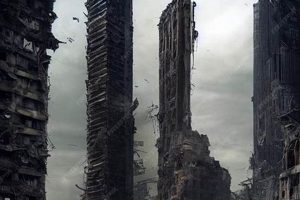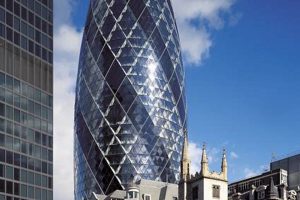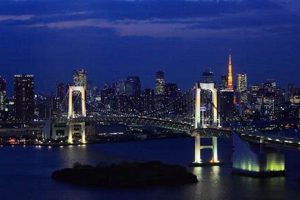A skyscraper silhouette is a distinctive and iconic feature of many modern cities. It is the outline of a tall building, often with a distinctive shape or design, that stands out against the sky. Skyscraper silhouettes can be seen from miles away and are often used as landmarks.
Skyscrapers have been built for over a century, and their silhouettes have evolved over time. Early skyscrapers were typically tall and narrow, with a simple rectangular shape. However, as architectural techniques have improved, skyscrapers have become taller and more complex, with a variety of shapes and designs. Some of the most famous skyscraper silhouettes in the world include the Empire State Building, the Chrysler Building, and the Burj Khalifa.
Skyscraper silhouettes are important for a number of reasons. They can be used to identify a city from a distance, and they can also be used to create a sense of place. For example, the silhouette of the Empire State Building is instantly recognizable and is often associated with New York City.
1. Height
Height is a defining characteristic of skyscraper silhouettes. It is what makes skyscrapers stand out from other buildings and gives them their iconic status. The height of a skyscraper can be used to create a variety of different effects, from awe-inspiring to intimidating. For example, the Burj Khalifa, the tallest building in the world, has a height of 828 meters (2,717 feet). This gives it a commanding presence on the Dubai skyline and makes it visible from miles away.
- Verticality and Dominance: Skyscrapers, by virtue of their height, create a sense of verticality and dominance. They reach towards the sky, symbolizing power, ambition, and progress. Their towering presence can evoke feelings of insignificance or grandeur, shaping the urban experience.
- Landmark and Identity: Height contributes to a skyscraper’s landmark status. It makes the building easily recognizable and creates a distinct identity. The Empire State Building, with its unmistakable silhouette, has become an iconic symbol of New York City.
- Urban Planning and Density: Height plays a crucial role in urban planning and density. Skyscrapers allow for more efficient land use, accommodating a large population within a limited area. This can be particularly important in densely populated cities.
- Engineering and Innovation: Constructing skyscrapers requires innovative engineering solutions to overcome challenges related to height, wind resistance, and structural stability. The pursuit of greater heights has pushed the boundaries of architectural and engineering capabilities.
In conclusion, height is an integral aspect of skyscraper silhouettes. It shapes their visual impact, creates landmarks, influences urban planning, and drives engineering innovation. The interplay of height with other design elements gives skyscrapers their distinctive character and makes them a defining feature of modern cities.
2. Shape
Shape is a fundamental aspect of skyscraper silhouettes, influencing their visual appeal, functionality, and structural integrity. Skyscrapers can take on a wide range of shapes, from simple rectangular forms to complex geometric designs. The shape of a skyscraper is often dictated by architectural intent, engineering constraints, and the surrounding urban environment.
One of the most common skyscraper shapes is the rectangular prism. This shape is simple to construct and provides efficient use of space. However, architects have also explored more complex shapes, such as pyramids, spheres, and even organic forms. These shapes can create a more striking visual impact and can also be used to improve the building’s performance. For example, a curved shape can help to reduce wind resistance and a sloped roof can help to shed rain and snow.
The shape of a skyscraper can also be used to express a particular architectural style or to reflect the culture of the city in which it is located. For example, the Art Deco skyscrapers of New York City are characterized by their stepped-back shapes and intricate ornamentation. In contrast, the modernist skyscrapers of Chicago are known for their simple, geometric forms and lack of ornamentation.
Understanding the connection between shape and skyscraper silhouette is important for architects, engineers, and urban planners. By carefully considering the shape of a skyscraper, they can create buildings that are not only visually appealing but also functional and structurally sound.
3. Design
Design is a crucial element that shapes skyscraper silhouettes. It encompasses the aesthetic choices, functional considerations, and engineering principles that determine a skyscraper’s overall appearance and performance. Design factors interact to create unique silhouettes that define city skylines and reflect architectural styles.
- Facade Design:
Facade design plays a significant role in creating the silhouette of a skyscraper. The choice of materials, patterns, colors, and textures can create striking visual effects and contribute to the building’s overall expression. For instance, the glass and steel facade of the Burj Khalifa gives it a sleek and modern appearance, while the intricate ornamentation of the Chrysler Building evokes an Art Deco style. - Rooftop Design:
The design of a skyscraper’s rooftop can have a major impact on its silhouette. Flat roofs provide a clean and simple look, while sloped roofs can create a more dynamic and visually interesting effect. Some skyscrapers feature elaborate rooftop structures, such as spires, antennas, or observation decks, which become distinctive elements of their silhouettes. For example, the Empire State Building’s iconic spire is an instantly recognizable part of its silhouette. - Architectural Style:
The architectural style of a skyscraper is reflected in its silhouette. Different architectural styles have distinct characteristics that shape the building’s overall form and details. For instance, Gothic skyscrapers often feature pointed arches and spires, while modernist skyscrapers emphasize clean lines and geometric shapes. The architectural style of a skyscraper can also be influenced by the cultural context in which it is built. - Sustainability Considerations:
Sustainability considerations are increasingly shaping the design of skyscrapers. Architects and engineers are exploring innovative ways to reduce energy consumption and environmental impact. This can lead to design features such as green roofs, solar panels, and wind turbines, which can become integral elements of a skyscraper’s silhouette. For example, the Bank of America Tower in
New York City features a sloping glass roof that maximizes natural light and reduces the need for artificial lighting.
In conclusion, design is a multifaceted aspect that profoundly influences skyscraper silhouettes. By carefully considering facade design, rooftop design, architectural style, and sustainability considerations, architects and engineers create iconic structures that define city skylines and embody the aspirations and values of our time.
4. Symbolism
Skyscraper silhouettes are deeply intertwined with symbolism, embodying cultural aspirations, societal values, and historical narratives. They often transcend their physical presence, becoming iconic representations of cities, nations, and even entire eras.
- Power and Prestige:
Skyscrapers have long been associated with power and prestige. Their towering height and imposing presence symbolize dominance, ambition, and economic strength. The Empire State Building in New York City, for example, has been a symbol of American economic power since its completion in 1931. - National Identity:
Skyscrapers can also embody national identity and pride. The Petronas Towers in Kuala Lumpur, Malaysia, are iconic symbols of the country’s economic and architectural prowess. Similarly, the Burj Khalifa in Dubai, United Arab Emirates, represents the nation’s ambitious vision and desire to be recognized on the global stage. - Cultural Heritage:
Skyscrapers can become symbols of cultural heritage, representing a specific architectural style or era. The Art Deco skyscrapers of New York City, for example, evoke the glamour and optimism of the early 20th century. The International Style skyscrapers of the mid-20th century, with their emphasis on glass and steel, represent a more modern and functional approach to architecture. - Urban Transformation:
Skyscrapers can symbolize urban transformation and the evolution of cities. The construction of skyscrapers has played a major role in shaping the skylines of cities around the world, transforming them into vibrant and dynamic urban centers. Skyscrapers represent the growth, ambition, and constant reinvention of cities.
In conclusion, the symbolism associated with skyscraper silhouettes is multifaceted and powerful. Skyscrapers represent not only physical structures but also cultural aspirations, societal values, and historical narratives. They are symbols of power, national identity, cultural heritage, and urban transformation, shaping our perception of cities and the world around us.
5. Identity
The silhouette of a skyscraper is a powerful symbol of identity, both for the individual building and the city in which it resides. A skyscraper’s unique shape and design can make it an iconic landmark, instantly recognizable and associated with a particular place or culture. For example, the Empire State Building is synonymous with New York City, while the Burj Khalifa is a symbol of Dubai.
Skyscrapers can also reflect the values and aspirations of the society that built them. For example, the Art Deco skyscrapers of the 1920s and 1930s were designed to convey a sense of optimism and progress. The modernist skyscrapers of the 1950s and 1960s, with their emphasis on glass and steel, represented a more forward-looking and international style. And the postmodern skyscrapers of the 1980s and 1990s often incorporated historical or cultural references into their designs.
Understanding the connection between identity and skyscraper silhouette is important for architects, urban planners, and anyone interested in the built environment. By carefully considering the design of a skyscraper, architects can create buildings that are not only visually appealing but also meaningful and reflective of the community they serve.
6. Engineering
Engineering is the science and art of designing and building structures and machines. Civil engineers play a crucial role in the design and construction of skyscrapers, ensuring they can withstand the forces of nature and remain safe for occupants.
- Structural Integrity: Structural engineers design the framework of a skyscraper to ensure it can withstand gravity, wind, and seismic forces. They must consider the weight of the building, the materials used, and the wind loads it will experience. For example, the Burj Khalifa, the tallest building in the world, has a reinforced concrete core that provides strength and stability.
- Wind Resistance: Wind can exert significant forces on a skyscraper, especially at high altitudes. Engineers use wind tunnels to test the design of a skyscraper and make sure it can withstand strong winds without swaying excessively. For example, the Taipei 101 skyscraper in Taiwan has a unique double-layer facade that helps to reduce wind resistance.
- Seismic Resistance: In earthquake-prone areas, skyscrapers must be designed to withstand seismic forces. Engineers use a variety of techniques to make skyscrapers more resistant to earthquakes, including base isolation systems and energy-dissipating devices. For example, the San Francisco Transamerica Pyramid has a base isolation system that allows the building to move independently of the ground during an earthquake.
- Sustainability: Engineers are increasingly designing skyscrapers to be more sustainable. This includes using energy-efficient materials, incorporating renewable energy sources, and reducing water consumption. For example, the One World Trade Center in New York City has a rainwater collection system that provides water for the building’s cooling system.
By carefully considering the engineering challenges involved in designing and constructing skyscrapers, engineers help to create safe, functional, and sustainable buildings that can stand the test of time.
7. Aesthetics
The aesthetics of a skyscraper silhouette play a significant role in shaping the overall impression of a building and its surrounding environment. Architects carefully consider the visual impact of a skyscraper’s silhouette, as it can influence the perception of the building’s height, form, and overall character.
One of the key aesthetic considerations in designing a skyscraper silhouette is the building’s form. The shape and proportions of a skyscraper can create a variety of different visual effects. For example, a tall and slender skyscraper will appear more graceful and elegant, while a shorter and wider skyscraper will appear more imposing and powerful. The choice of form can also be influenced by the surrounding buildings and the overall urban context.
Another important aesthetic consideration is the building’s facade. The facade is the exterior surface of the building, and it can be designed in a variety of ways to create different visual effects. For example, a glass facade can create a sense of transparency and lightness, while a stone facade can create a sense
of solidity and permanence. The choice of facade materials and design can also be influenced by the building’s function and the desired aesthetic effect.
The aesthetics of a skyscraper silhouette can also be affected by the building’s lighting. Lighting can be used to highlight certain features of the building’s design and to create a variety of different moods and atmospheres. For example, a building can be lit to emphasize its height or to create a sense of drama and excitement.
Understanding the connection between aesthetics and skyscraper silhouette is important for architects and urban planners. By carefully considering the aesthetic impact of a skyscraper’s silhouette, they can create buildings that are not only visually appealing but also harmonious with their surroundings.
8. Urban planning
Urban planning plays a crucial role in shaping the silhouette of a city’s skyline. It involves the regulation and design of the built environment, including the placement and design of skyscrapers. Urban planners consider various factors to ensure that skyscrapers complement the surrounding urban fabric and contribute positively to the overall cityscape.
- Zoning and setbacks: Zoning regulations determine the permitted height, size, and location of skyscrapers. Setbacks, which are required spaces between buildings, help to ensure adequate sunlight, ventilation, and views for surrounding buildings and public spaces.
- Density and land use: Urban planners consider the density of skyscrapers in relation to other land uses, such as residential, commercial, and green spaces. This helps to create a balanced and livable urban environment.
- Contextual design: Skyscrapers are designed to complement and enhance the surrounding urban context. Planners consider the architectural style, materials, and colors of existing buildings to ensure that new skyscrapers harmonize with their surroundings.
- Public spaces and connectivity: Urban planning integrates skyscrapers with public spaces, such as parks, plazas, and pedestrian walkways. This creates a cohesive urban environment that encourages interaction and accessibility.
By carefully considering these factors, urban planners help to create skyscraper silhouettes that are not only visually appealing but also functional and sustainable. Well-planned skyscraper silhouettes contribute to the overall character and identity of a city, making it a desirable place to live, work, and visit.
9. Cultural significance
Skyscrapers are more than just tall buildings; they are cultural icons that reflect the aspirations, values, and identity of the societies that build them. The silhouette of a skyscraper can evoke a sense of awe, power, and progress. It can also symbolize a city’s economic strength and global standing.
For example, the Empire State Building in New York City is an iconic symbol of American capitalism and ambition. The Petronas Towers in Kuala Lumpur, Malaysia, are a symbol of the country’s economic and architectural prowess. And the Burj Khalifa in Dubai, United Arab Emirates, is a symbol of the city’s ambitious vision and desire to be recognized on the global stage.
Understanding the cultural significance of skyscraper silhouettes is important for architects, urban planners, and anyone interested in the built environment. By carefully considering the cultural context in which a skyscraper is built, architects can create buildings that are not only visually appealing but also meaningful and reflective of the community they serve.
FAQs on Skyscraper Silhouettes
Skyscraper silhouettes are iconic features of modern cities, shaping skylines and serving as landmarks. They offer various dimensions for exploration, and understanding them enhances our appreciation of architecture and urban development. Here are some frequently asked questions that delve into the significance and characteristics of skyscraper silhouettes:
Question 1: What is the importance of skyscraper silhouettes in shaping a city’s identity?
Skyscraper silhouettes are closely tied to a city’s identity and can become instantly recognizable symbols. They reflect the aspirations, values, and cultural context of the society that built them. By embodying power, prestige, and economic strength, skyscraper silhouettes contribute to a city’s unique character and global recognition.
Question 2: How do engineering advancements influence skyscraper silhouettes?
Engineering plays a crucial role in determining the height, shape, and structural integrity of skyscraper silhouettes. Innovations in materials, structural design, and wind resistance enable architects to push the boundaries of architectural expression. These advancements allow for the creation of taller, more complex, and sustainable skyscrapers that redefine city skylines.
Question 3: What factors contribute to the aesthetic appeal of skyscraper silhouettes?
The aesthetic appeal of skyscraper silhouettes stems from a combination of factors. Architects carefully consider the building’s form, facade design, and lighting to create visually striking and harmonious structures. The interplay of height, proportion, and materials influences the overall impression of elegance, grandeur, or dynamism.
Question 4: How does urban planning impact the development of skyscraper silhouettes?
Urban planning plays a vital role in shaping skyscraper silhouettes through zoning regulations and design guidelines. It ensures the orderly development of cities, regulates building heights and setbacks, and promotes contextual design. Urban planning considers the impact of skyscrapers on sunlight, ventilation, and public spaces, fostering a balanced and livable urban environment.
Question 5: What is the cultural significance of skyscraper silhouettes?
Skyscraper silhouettes often transcend their physical presence and become cultural icons. They symbolize a city’s economic power, national pride, and architectural achievements. By embodying the aspirations and values of a society, skyscraper silhouettes contribute to a city’s cultural identity and heritage.
Question 6: How can skyscraper silhouettes contribute to sustainability?
In recent years, sustainability has become an increasingly important consideration in skyscraper design. Architects incorporate energy-efficient materials, utilize renewable energy sources, and employ innovative facade systems to reduce energy consumption and environmental impact. Sustainable skyscraper silhouettes not only enhance the building’s performance but also contribute to the overall sustainability of the urban environment.
In conclusion, skyscraper silhouettes offer a multifaceted perspective on architecture, engineering, urban planning, and cultural significance. Understanding the interplay between these factors allows us to appreciate the iconic status of skyscrapers and their contributions to the shaping of modern cities.
Transition to the next article section: Exploring the Evolution of Skyscraper Silhouettes
Tips for Designing Skyscraper Silhouettes
Skyscraper silhouettes are iconic representations of cities, embodying architectural prowess a
nd cultural aspirations. Designing visually striking and structurally sound skyscraper silhouettes requires careful consideration of various factors. Here are five tips to guide architects and urban planners in creating impactful skyscraper silhouettes:
Tip 1: Consider the Urban Context
Skyscraper silhouettes should complement and enhance the surrounding urban fabric. Architects should consider the scale, style, and density of existing buildings to ensure the new skyscraper integrates harmoniously. Preserving sightlines and respecting historical landmarks are crucial for maintaining the city’s character.Tip 2: Explore Innovative Structural Systems
Pushing the boundaries of height and form requires innovative structural systems. Engineers should explore advanced materials, such as composite structures and high-strength concrete, to achieve daring designs while ensuring structural stability. Wind tunnel testing and seismic analysis are essential for optimizing performance and mitigating potential risks.Tip 3: Optimize Facade Design
The facade plays a pivotal role in shaping the skyscraper’s silhouette and overall aesthetic. Architects should carefully select materials, patterns, and colors to create visually appealing facades. Consider the interplay of light and shadow, and explore innovative glazing systems to enhance natural light penetration and reduce energy consumption.Tip 4: Integrate Sustainable Features
Sustainability should be an integral part of skyscraper design. Incorporate energy-efficient lighting, rainwater harvesting systems, and green roofs to reduce environmental impact. Employ passive design strategies, such as solar shading and natural ventilation, to minimize energy consumption and enhance occupant comfort.Tip 5: Foster Collaboration
Successful skyscraper design requires collaboration among architects, engineers, urban planners, and stakeholders. Open communication and a shared vision are essential for achieving innovative and contextually appropriate designs. Encourage interdisciplinary teamwork to leverage diverse perspectives and expertise.
By following these tips, architects and urban planners can create skyscraper silhouettes that are not only visually stunning but also structurally sound and sustainable. These iconic structures will continue to define our cities, symbolizing human ingenuity and the pursuit of architectural excellence.
Transition to the article’s conclusion:
Skyscraper Silhouettes
Skyscraper silhouettes have emerged as iconic symbols of modern cities, shaping skylines and embodying cultural aspirations. This article has explored the multifaceted dimensions of skyscraper silhouettes, delving into their engineering, aesthetics, urban planning, and cultural significance.
Skyscraper silhouettes are not merely architectural feats; they are expressions of societal values, technological advancements, and urban ambitions. By understanding the interplay between these factors, we can appreciate the profound impact skyscraper silhouettes have on our cities and our collective imagination.
As we look towards the future, skyscraper silhouettes will continue to evolve, reflecting the ever-changing nature of our cities and societies. Architects, engineers, and urban planners have the responsibility to design skyscraper silhouettes that are not only visually striking but also structurally sound, sustainable, and inclusive. By embracing innovation and collaboration, we can create skyscraper silhouettes that inspire, elevate, and continue to define the urban landscape for generations to come.







